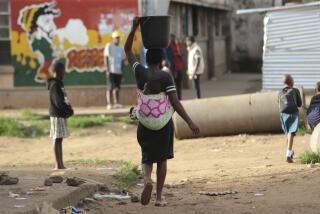U.N. Rates Efforts to Better Lives of Women, Children : Conditions: U.S. trails many nations in UNICEF rankings for education and family planning.
- Share via
WASHINGTON — The United Nations Children’s Fund rated the nations of the world today on improving conditions for children and women and gave the United States mediocre scores.
In this nation, for example, 94% of girls finish fifth grade, a rate that ranked the United States only 21st among industrial nations. Six developing countries had higher percentages: Jamaica (99%), Hong Kong (99%), Singapore (98%), Turkey (97%), Uruguay (96%) and Sri Lanka (95%). In six industrial countries--Austria, Finland, Israel, Japan, Sweden and Switzerland--100% of girls finished fifth grade.
In another category, the percentage of married women of child-bearing age who use some form of family planning, the United States ranked 10th among industrial nations--tying with Slovakia--with 74%. France led industrial nations with 80%. China led the world with 83%.
In its rankings, which it called a score sheet, UNICEF was mostly concerned with whether the developing world was reaching targets set by leaders at the World Summit for Children in 1990.
In a statement accompanying the report, James P. Grant, UNICEF executive director, said, “As we near the middle of the decade, I can say that practical progress is being made toward a majority of the goals by a majority of the developing nations, and the lives of hundreds of millions of children are being improved as a result of these largely un-publicized efforts.”
One goal was to reduce child malnutrition 20% by 1995 and 50% by 2000. While the report said most countries would meet the targets, 31 would not, either because of war, lack of resources or lack of a strategy.
Among those unlikely to meet the goals because of lack of a strategy were Mexico and Nigeria. El Salvador, Pakistan and India were among those that had a nutrition strategy in place but too few resources to make meaningful strides. The countries that would fail because of war or some kind of internal strife included Angola, Burundi, Haiti, Lesotho, Liberia, Mozambique, Rwanda, Somalia, Sudan and Zaire.
Some of the reports were surprising. The summit had agreed to prevent goiter by iodizing all salt supplies by 1995. But UNICEF said 29 countries had no plans to do this even though goiter had become or was about to become a public health problem. Most were developing countries but the list included Germany, Italy, Spain, Greece, Albania and Portugal. The United States had no problem of iodine deficiency disorders.
UNICEF also rated all countries on what it called “national performance gaps.” This measured whether a country was using its wealth to tackle problems of its children.
Here, UNICEF calculated what a country should have achieved in child survival, nutrition and education based on its per capita gross national product. The difference between what it should have achieved and actually did, UNICEF termed its national performance gap, which could be minus or positive.
UNICEF said the United States, based on its wealth, should have a mortality rate of 10 per 1,000 for children younger than 5. Because the nation’s mortality rate equals that estimate, there is no gap in child survival. On the other hand, based on its wealth, 97% of U.S. girls should finish fifth grade. Because only 94% finish, the United States has a performance gap of minus 3 in education.
In comparison with the U.S. scores, almost all other industrial countries have plus ratings in child survival; only Belgium has a larger negative gap in education.
Disparities between nations are enormous. In Africa, for example, Kenya has national performance gaps of plus 67 in child survival, plus 21 in education and plus 15 in nutrition, which is measured by the percentage of children younger than 5 who are underweight. Niger, on the other hand, has national performance gaps of minus 173 in child survival, minus 21 in education and minus 6 in nutrition.
More to Read
Sign up for Essential California
The most important California stories and recommendations in your inbox every morning.
You may occasionally receive promotional content from the Los Angeles Times.












